
Space Allocation Software: What It Is and How It Helps your Businesses
Space allocation software offers businesses a way to organize their working spaces better. With higher real estate costs and a rising trend towards flexible work setups, managing space wisely has gained importance.
Inefficient space use often results in overcrowded areas, empty rooms, and wasted resources. Space allocation systems tackle these issues by tracking how every square foot is used and suggesting ways to optimize it.
In this article, we will discuss space allocation software, its key features, and how it helps businesses make the most of their spaces. We’ll also cover the leading solutions available and how to choose the right software for your needs.
What Is Space Allocation Software?
Space allocation software enables businesses to optimize and manage office spaces by tracking real-time space utilization and providing tools for strategic space planning. The software helps:
- Create digital floor plans
- Monitor occupancy in real-time
- Analyze office space usage with its reporting features
Office space management software often includes drag-and-drop floor plan tools, allowing users to adjust office layouts and maximize space utilization easily.
Space allocation software goes beyond tracking empty offices or crowded areas. It identifies underutilized spaces and helps facility managers make informed decisions about office layouts, seating, and future space requirements.
Key Features of Space Allocation Software
Space allocation software offers features that help businesses improve space utilization. These tools support space planners, facility managers, and office management teams. You can use them to optimize your real estate portfolio and enhance the overall workplace experience.
Real-Time Space Utilization Data
Real-time utilization data helps businesses track space usage across various office spaces. This feature provides insights into which spaces are heavily used and which areas remain underutilized, including:
- Desks
- Meeting rooms
- Shared areas
With real-time data, office managers and space planners can identify underused areas and make decisions to maximize space utilization. For example, if some office spaces or meeting rooms often remain empty, managers can consider repurposing them to meet current or future space requirements.
Digital Floor Plans and Drag-And-Drop Layout Tools
Digital floor plans and drag-and-drop layout tools make it easy to create, adjust, and visualize office layouts.
Space planning managers use these tools to design layouts that support efficient office space use, including seating arrangements, meeting room configurations, and flexible work areas.
Drag-and-drop functionality simplifies space planning, allowing businesses to test various layouts and adjust as needs change. This flexibility helps businesses manage hybrid work models or adapt to fluctuations in staffing.
Occupancy Sensors and Data Collection
A space management solution includes occupancy sensors to gather accurate data on how office spaces are used. These sensors track metrics like:
- Desk usage
- Meeting room occupancy
- Overall space flow
Occupancy sensors also help businesses manage energy consumption by automatically adjusting lighting and climate controls based on room occupancy. This supports cost savings and aligns space usage with actual needs.
Reporting Features and Customizable Analytics
Comprehensive reporting features and office space analytics give businesses valuable insights into their real estate footprint, space utilization, and cost metrics. Custom reports allow managers to track key metrics such as occupancy rates, energy consumption, and peak usage times for conference rooms.
These reports also aid in strategic planning by providing data on space allocation by department or team. Businesses can create custom reports that highlight areas of improvement, track space usage patterns, and make informed decisions about future space requirements.

Integration With Workplace Management Software
Many space allocation software solutions integrate smoothly with an office management tool. It includes tools such as:
- Visitor management systems
- Employee scheduling software
- Project management platforms
This integration allows businesses to manage visitor flow, track space utilization, and organize resources from one central platform. For instance, integrating space planning software with a visitor management tool allows a space planning manager to book desks and reserve meeting rooms with ease.
Intuitive Dashboards for Decision-Making
Intuitive dashboards consolidate key metrics and data on space usage, occupancy, and seating arrangements, giving facility managers and office planners a quick overview of space allocation. These dashboards display real-time utilization data in a user-friendly format.
With the ability to track key metrics through an intuitive dashboard, managers can respond to changes promptly, make better decisions, and create a workplace that supports employee satisfaction and efficiency.
Top 5 Space Allocation Software Platforms in 2024
Selecting the right space allocation software supports effective office layouts, optimizes space usage, and promotes efficient work environments.
1. DeskFlex
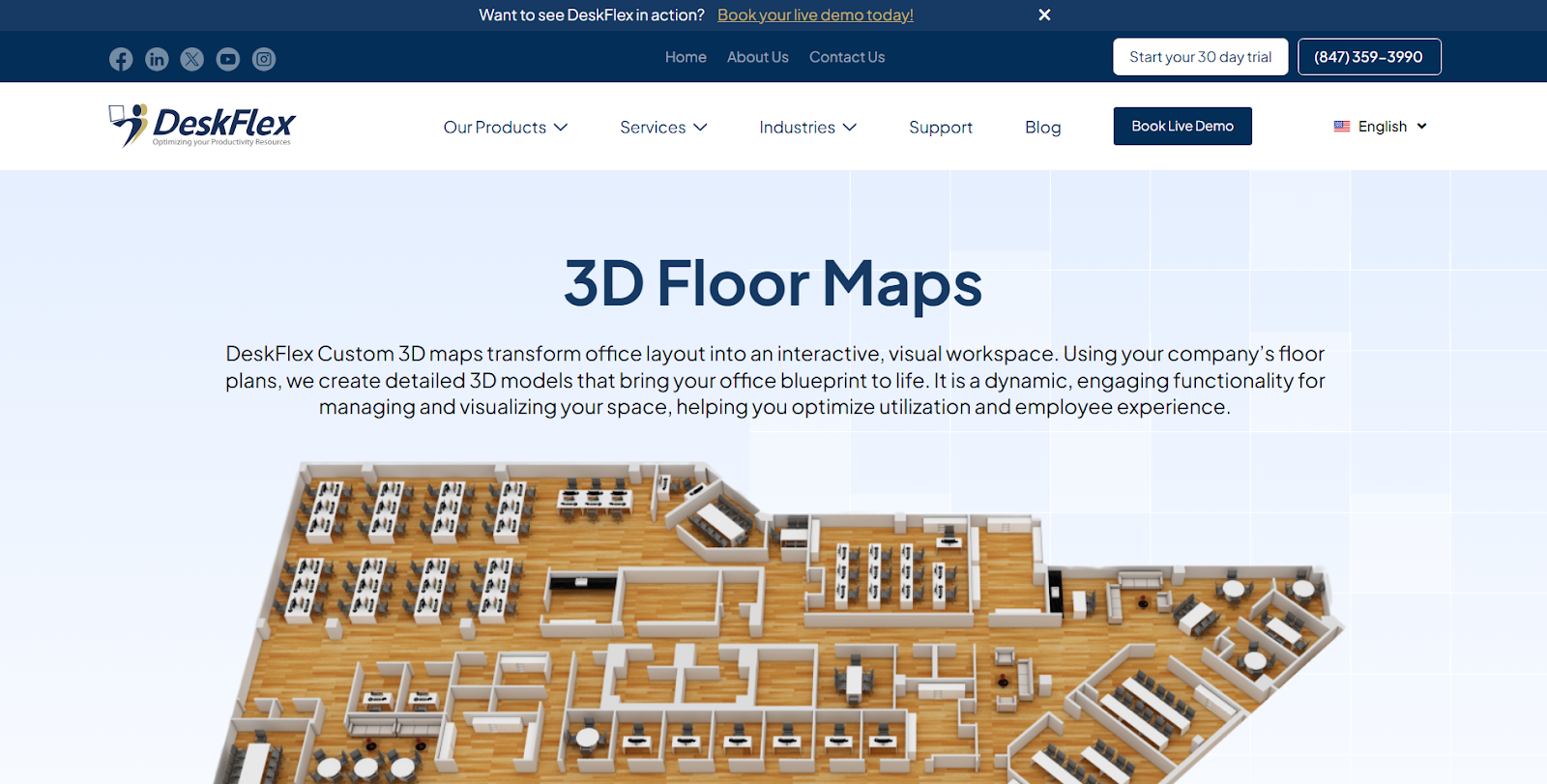
DeskFlex offers a comprehensive solution for managing space allocation with features like 3D floor maps and advanced room planning. The platform transforms office layouts into interactive 3D models based on custom floor plans, helping businesses visualize and optimize their workspace.
Its 3D mapper displays each employee’s profile synced with Windows Active Directory, making it easy to see who occupies specific workstations. Its flexible floor plan creator app also allows administrators to move employees between spaces easily.
The platform supports desk sharing and room scheduling. It visually displays available and reserved desks, helping employees and teams find the right space quickly.
Key features:
- Custom 3D floor maps for dynamic office layouts
- Easy-to-use interface with flexible desk and room booking
- Improved team member retention through engaging workspace planning
- Real-time reservation information and automated room scheduling scenarios
- Support for hoteling, hot desking, and virtual office setups
Book a demo and experience the impact of DeskFlex today!
2. Skedda
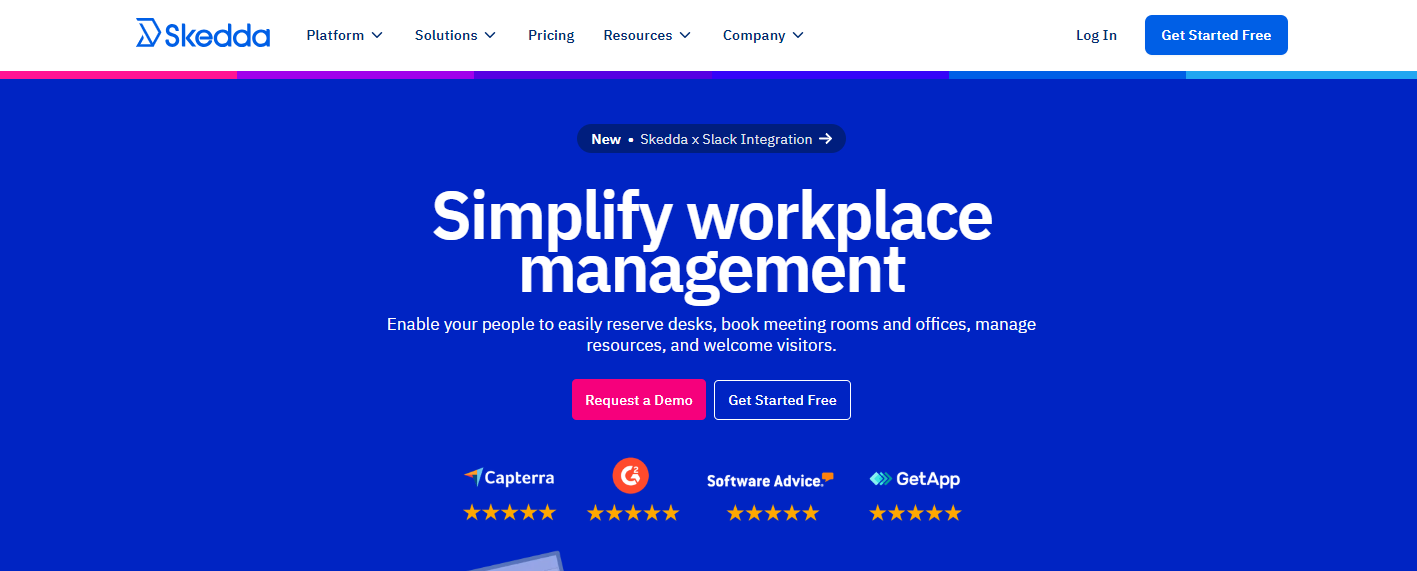
Source: Skedda
Skedda offers a workspace management platform that enables employees to book spaces effortlessly. Interactive floorplans provide a clear view of available office spaces, allowing users to reserve desks or rooms directly on a digital map.
Skedda’s automation rules allow control over booking policies and quotas, while integrations with Microsoft 365, Google Workspace, and other tools make connecting Skedda to existing workflows easy. Single sign-on (SSO) options can also simplify access through familiar credentials.
Skedda’s mobile app lets employees book spaces from any device, making the reservation process more convenient. The platform’s comprehensive support team assists users, making it a practical choice for space management.
Key features:
- Interactive floorplans for easy booking
- Analytics for data-driven space optimization
- Visitor management for guest organization
- Automation rules for booking policies
3. OfficeSpace
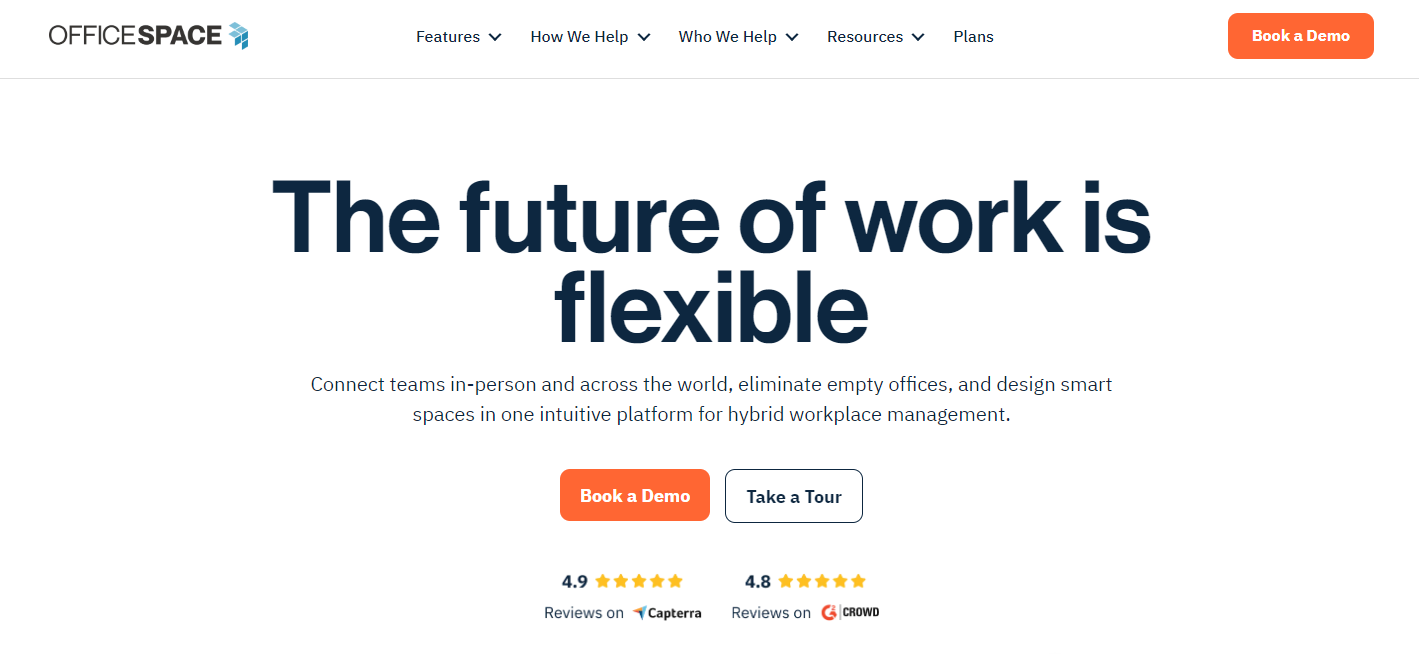
Source: OfficeSpace
OfficeSpace provides a solution for workspace management and planning. With Workplace Intelligence Dashboards, OfficeSpace offers insights into space utilization, occupancy, and allocation, helping companies monitor workspace efficiency and address areas of underuse.
The platform combines multiple data sources such as badge, WiFi, and sensor data, giving a full view of office usage and supporting accurate decision-making.
Forecasting tools help managers anticipate future needs, adjust space allocations, and prepare for key lease dates.
OfficeSpace’s scenario and stack planning features allow teams to experiment with different configurations. Hybrid space management tools make it easy to handle bookings, while the Visual Directory and mobile app provide quick access for employees to locate and reserve workspaces.
Key features:
- Dashboards for space utilization insights
- Integrated data sources for comprehensive tracking
- Forecasting tools for future space planning
- Scenario and stack planning for flexible layouts
4. HubStar
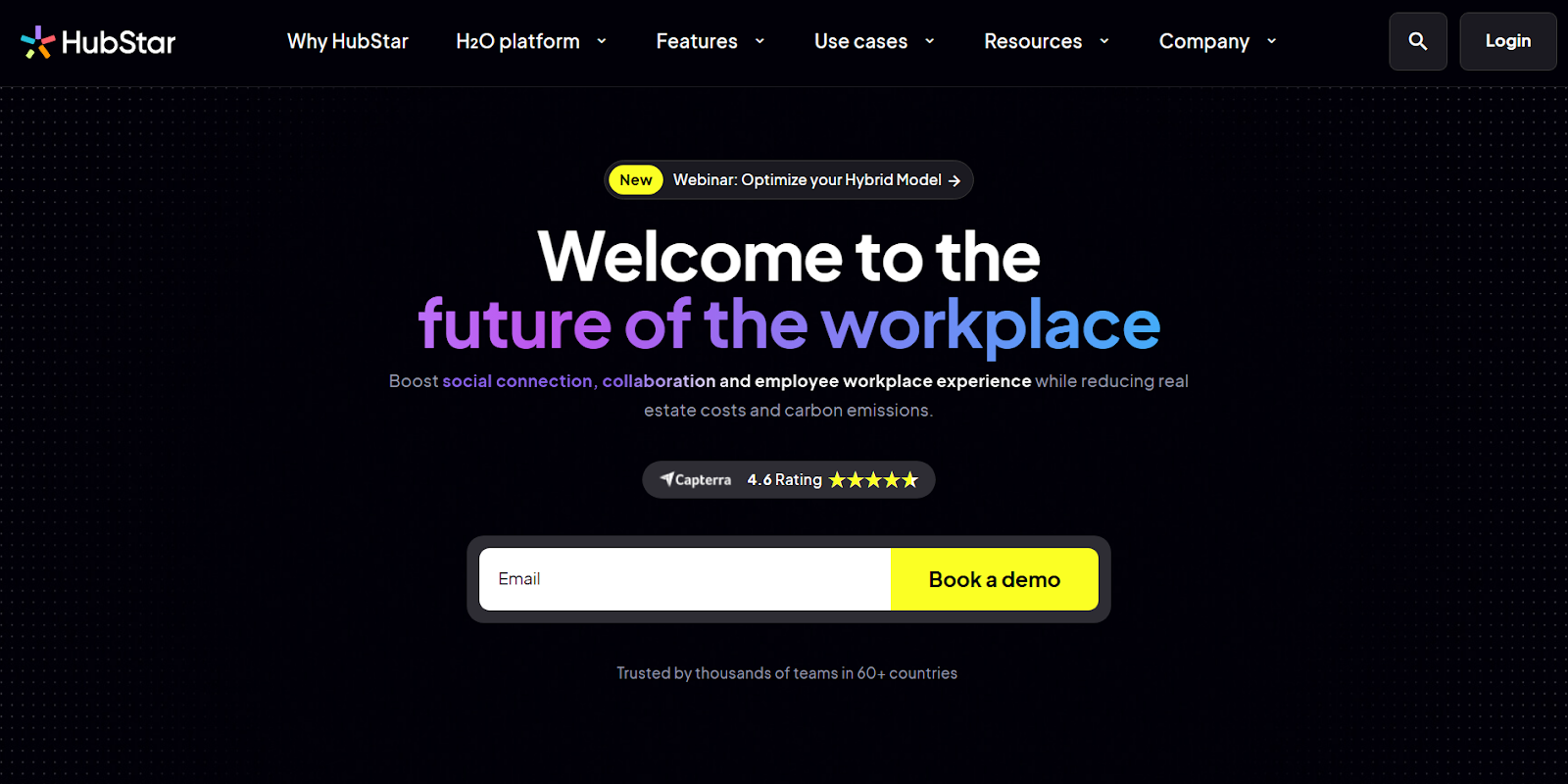
Source: HubStar
HubStar Space is used to manage hybrid workplaces. With flexible floor plan imports, companies can bring in floor plans in any format and adjust employee-facing layouts. HubStar allows space assignments based on hybrid occupancy profiles, supporting different work schedules.
HubStar’s standardized floor plans simplify layout sharing and updates while automated polylining speeds up the editing process. It aligns space availability with employee demand, making it easy to adjust seating and layouts frequently.
Predictive analytics and machine learning offer insights into space utilization patterns, providing actionable suggestions for space allocation. Custom alerts notify managers if spaces are near full capacity or when occupancy levels change unexpectedly, supporting proactive adjustments.
Key features:
- Flexible floor plan imports and editing
- Hybrid occupancy profiles for adaptable space assignments
- Standardized floor plans for easy sharing
- Predictive analytics with machine learning insights
5. UnSpot
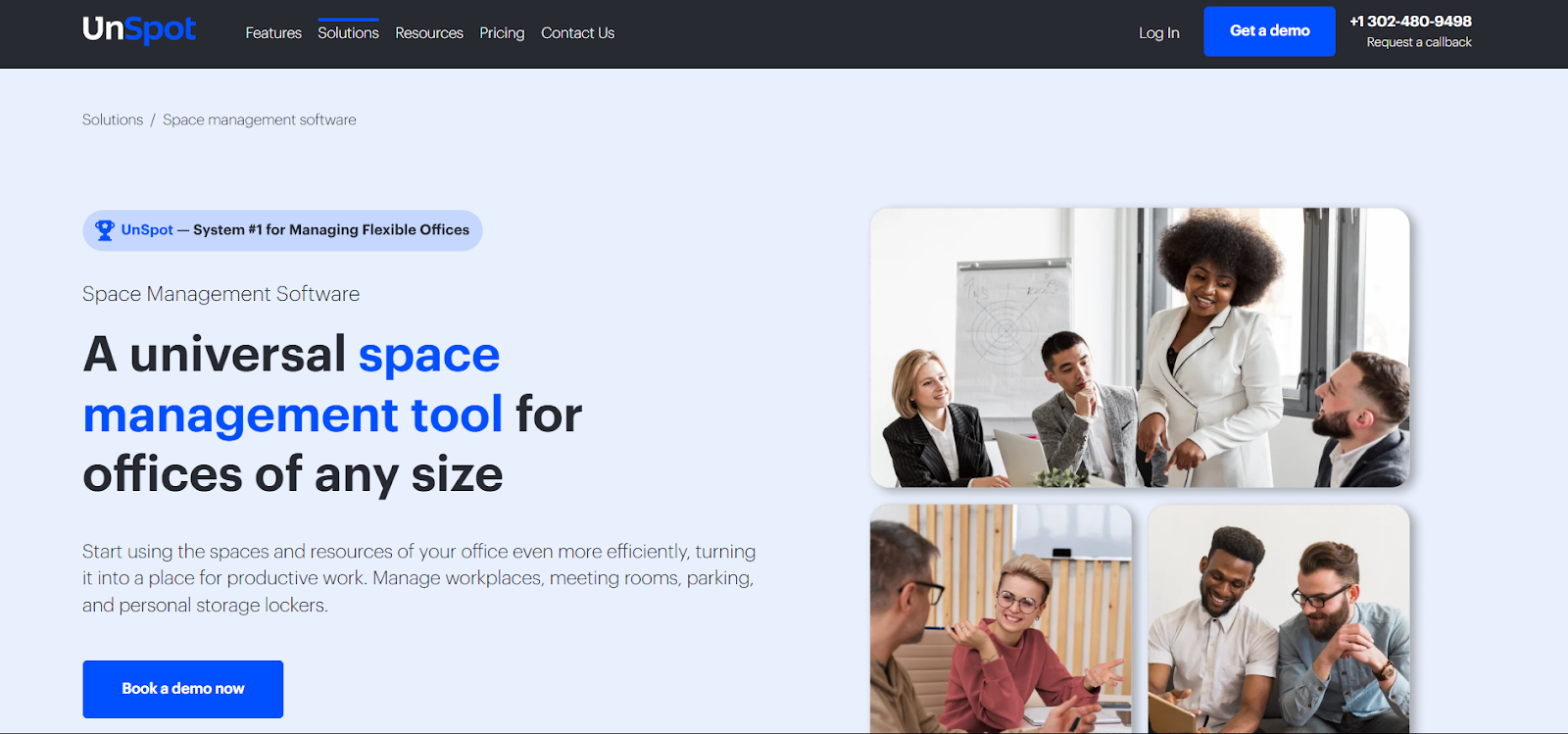
Source: UnSpot
UnSpot offers a space allocation tool designed to help offices use their resources efficiently. The software allows users to manage workstations, meeting rooms, parking spaces, and personal lockers, all through a single platform.
UnSpot’s digital tools let employees book workspaces, reserve parking, or select storage lockers with ease. The interactive office map and 24-hour dashboard make it simple to find and reserve available spaces.
With UnSpot, offices can improve resource allocation and create a productive, well-organized environment. It provides data-driven insights into office usage, with booking options that support easy navigation and reservation for employees and guests alike.
Key Features:
- Interactive map and dashboard for workspace and resource booking
- Office usage analytics to monitor workspace and resource efficiency
- Data-based insights on popular and underused spaces
- Customizable reservation policies for different user groups
How to Choose the Right Space Allocation Software
Selecting space allocation software involves knowing your specific needs and exploring options that meet them.
Follow these five steps to choose the best software for your workspace:
1. Identify Your Space Management Needs
Start by listing what your office requires from space allocation software. This may include managing office reservations, tracking room usage, or supporting hybrid work schedules. Clarifying your needs helps narrow down choices to software with the right features.
2. Assess Integration With Existing Tools
Look at the tools your office already uses, like:
- Calendar apps
- Access control systems
- Communication platforms
Choose software that integrates smoothly with these tools, so your team can continue using familiar systems without extra steps.
3. Test the Software With a Free Trial
Many providers offer free trials or demos. Use this opportunity to explore the software’s layout, booking process, and reporting features. Include feedback from your team to evaluate how user-friendly and efficient the platform feels.
4. Review Customization and Reporting Options
Consider whether the software lets you customize options like booking policies or access permissions for different teams. Check the reporting tools to confirm they provide useful data on space usage and occupancy rates, which can help optimize your workspace setup’s efficiency.
5. Evaluate Customer Support and Security Standards
Strong customer support and security are important for any software handling workspace data. Choose a provider that offers reliable support options and meets security standards, such as GDPR compliance or ISO certifications, to keep your data safe.
Why Space Utilization and Space Management Matter
Efficient space utilization and effective space management directly impact a company’s budget and the overall workplace experience. By maximizing space usage, businesses can reduce costs, support employee satisfaction, and maintain a well-organized office environment.
Impact on Costs and Workplace Experience
Effective use of office space affects both operational costs and employee experiences. Real estate expenses are a major part of a company’s budget, and unoccupied areas or empty desks represent wasted investment.
Overcrowded or poorly managed spaces can:
- Lower employee satisfaction
- Decrease productivity
- Create a less comfortable work environment
Space planning software offers a solution by tracking space utilization and identifying areas that need improvement. By using this software, businesses can keep costs down while creating an office space that supports employee needs.
Supporting Employee Satisfaction and Productivity
An organized, well-planned workspace creates a better experience for employees. Effective office layouts and seating arrangements help employees work comfortably and productively, reducing frustration and improving satisfaction.
Space management software helps businesses create these positive environments by offering insights into how spaces are used and where adjustments are needed to meet employee needs.
Identifying Inefficiencies in Office Space
Empty desks, unused conference rooms, and overcrowded areas often highlight gaps in space planning. Space management tools help businesses detect these inefficiencies, allowing them to:
- Adjust layouts
- Improve seating arrangements
- Allocate space based on actual needs
Properly managing space usage reduces costs and creates a functional workplace that benefits both employees and management.
Maximizing Space Utilization and Flexibility
Space management software allows companies to make the most of their space. This software supports flexible office setups, including hybrid work models, by providing adaptable floor plans that can change with the company’s requirements.
Whether tracking real-time data for hot desking areas or adjusting conference room layouts to fit new needs, space management solutions help businesses keep their workspaces functional and ready for changes.
Optimize Productivity in Your Office Space With Deskflex
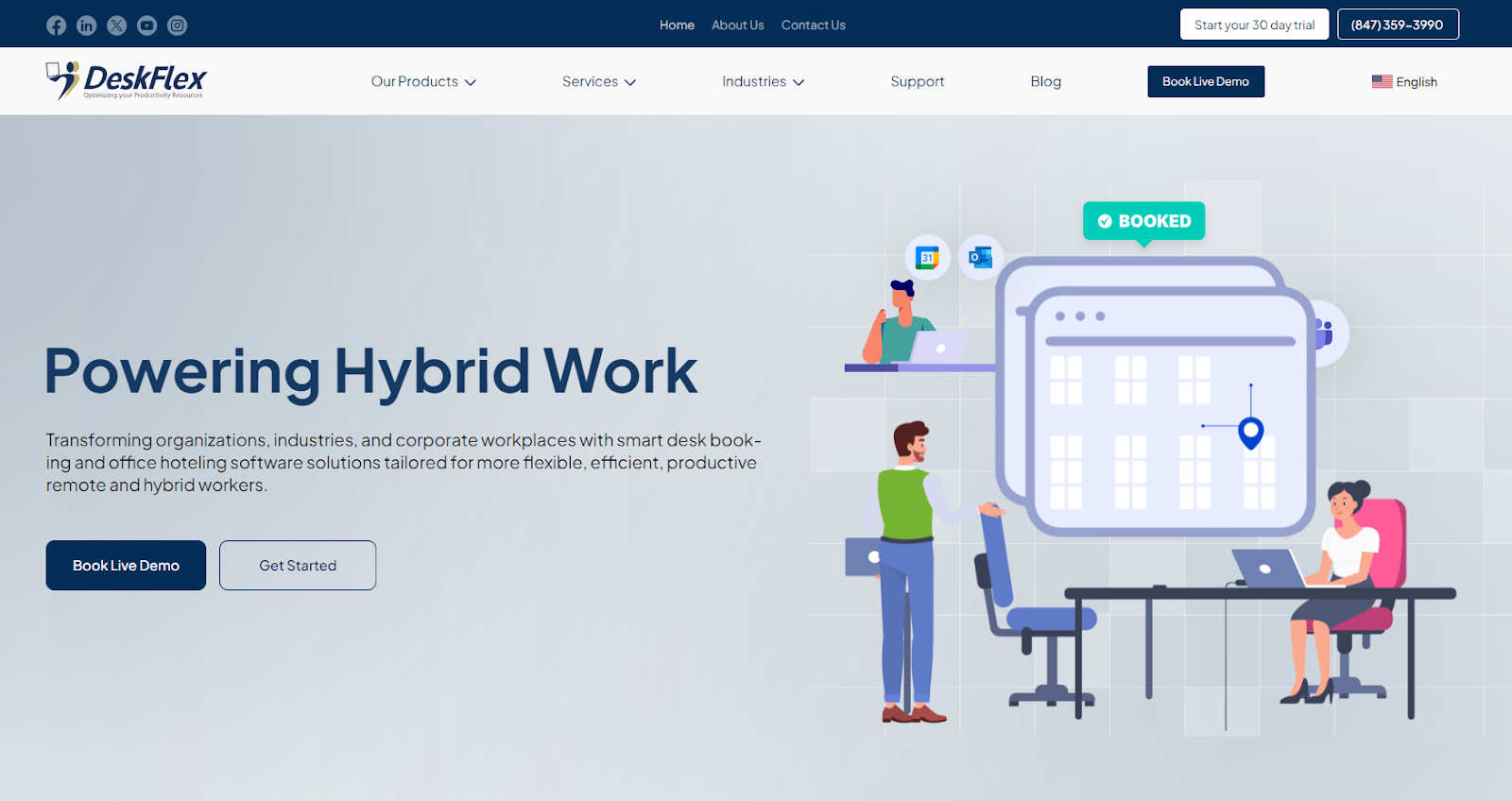
DeskFlex is an intuitive platform that provides everything you need to manage your space. From easy booking and automated billing to insightful analytics, It helps you keep operations organized while delivering a smooth member experience.
DeskFlex allows your team to manage desks, meeting rooms, parking spaces, and other resources with ease. Members can book spaces, handle payments, and connect with the community—all in a user-friendly interface.
Whether your coworking space is small or expanding to multiple locations, DeskFlex adapts to fit your setup.
With built-in analytics, DeskFlex lets you see exactly how your space is used. Identify popular resources, spot trends, and adjust to maximize productivity and member engagement.
Ready to see DeskFlex in action? Book your demo today!
FAQs About Space Allocation Software
What does space allocation software do?
Space allocation software helps manage and organize office layouts, desk assignments, meeting room bookings, and other shared resources. It provides tools to monitor space usage and optimize layouts to match employee needs, making it easier for businesses to use their physical space effectively.
Can space allocation software be used in hybrid work environments?
Yes, space allocation software is ideal for hybrid work environments. It allows employees to reserve desks, meeting rooms, and other resources on days when they plan to work on-site. This flexible setup helps hybrid teams manage office space efficiently and avoids overcrowding.
How can space allocation software help reduce office costs?
By analyzing space usage, space allocation software can reveal underused areas in the office. Businesses can use this data to repurpose or downsize these spaces, saving on rent, utilities, and maintenance costs. In some cases, businesses may even consolidate spaces to further reduce expenses.
What types of businesses benefit from space allocation software?
Businesses of all sizes can benefit from space allocation software, but it is especially useful for larger companies, coworking spaces, and organizations with flexible work arrangements. This software is also valuable for industries where space usage varies frequently, such as technology, consulting, and education.
How secure is the data within space allocation software?
Most space allocation software providers prioritize data security by implementing encryption, access controls, and regular software updates. Many platforms also comply with security standards, such as GDPR or ISO certifications, to protect sensitive information and ensure user privacy.



















































 Support
Support  Demo
Demo  Blog
Blog 


